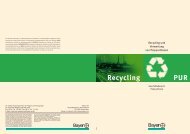Here - Polyurethanes - Bayer
Here - Polyurethanes - Bayer
Here - Polyurethanes - Bayer
You also want an ePaper? Increase the reach of your titles
YUMPU automatically turns print PDFs into web optimized ePapers that Google loves.
Baydur ®/Bayflex ® – <strong>Polyurethanes</strong> for Design and Functionality<br />
A MATERIAL THAT<br />
POINTS THE WAY FORWARD<br />
Wood, one of the oldest materials known to man, is also one of the most fascinating.<br />
However, this popular material does have its limits in terms of what it can be used for.<br />
Being a natural raw material, wood is not resistant to weathering. Its high tendency<br />
to warp has also forced engineers to look for alternatives in some areas where wood is<br />
traditionally used.<br />
“Eslon Neo Lumber FFU” is an extremely dimensionally<br />
stable composite material based on<br />
Baydur ® 60 reinforced with long glass fibers. It<br />
is produced by Sumika <strong>Bayer</strong> Urethane Co. Ltd.,<br />
a subsidiary of <strong>Bayer</strong> MaterialScience AG.<br />
The Japanese company Sekisui Chemical has<br />
been successfully selling this product for over<br />
20 years as a construction material for the<br />
Asian market. There, the sophisticated composite<br />
material has proved its worth in a wide<br />
variety of applications, particularly where<br />
technical considerations mean that it is not<br />
practical to use wood, but where the engineers<br />
would still like to benefit from the ease of<br />
processing associated with wood. Common<br />
applications include pools for fish farming,<br />
silos, walkways, soil anchors (where it is used<br />
as a substitute for concrete) and, above all,<br />
railway sleepers.<br />
European debut: The Zollamt bridge<br />
in Vienna has been fitted with<br />
polyurethane railway sleepers<br />
Now, this versatile material has made its debut<br />
in Europe. As part of a renovation project, the<br />
tracks on the Zollamt bridge in Vienna have<br />
been laid on sleepers made from polyurethane.<br />
“Eslon Neo Lumber is particularly well suited to<br />
use on bridges as it offers clear advantages over<br />
wood,” says Max Nakai from Sekisui Chemical<br />
Deutschland. “Changes in temperature, UV radiation<br />
and in particular the fact that the air is<br />
always humid mean that wooden sleepers<br />
weather more quickly here than in other<br />
applications. The problem is that carrying out<br />
structural repairs to railway tracks not only<br />
involves considerable inconvenience but is<br />
also very expensive.”<br />
The Zollamt bridge in Vienna<br />
This is also the case with the Zollamt bridge,<br />
which was designed by the Viennese art<br />
nouveau architect Otto Wagner and was<br />
constructed in 1898 when the Viennese city<br />
rail network was built. Materials with a long<br />
service life quickly pay for themselves in<br />
applications like this. Sekisui produces the<br />
polyurethane-glass fiber compound FFU (FFU









